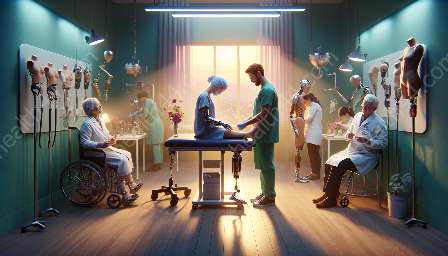Respiratory devices, such as ventilators and CPAP machines, play a crucial role in managing respiratory conditions and improving patients' quality of life. These innovative devices are designed to work in harmony with prosthetic and other medical equipment, offering comprehensive care and support to individuals with respiratory challenges. In this comprehensive guide, we will delve into the latest advancements in respiratory devices and their compatibility with prosthetic devices and other medical equipment.
The Evolution of Respiratory Devices
Respiratory devices have undergone significant advancements over the years, revolutionizing the way respiratory conditions are managed. Ventilators, also known as mechanical ventilators, are life-saving devices that support individuals with breathing difficulties by delivering oxygen to the lungs and removing carbon dioxide from the body. These devices have become increasingly sophisticated, featuring advanced control systems and monitoring capabilities to ensure precise and personalized respiratory support.
Similarly, CPAP (Continuous Positive Airway Pressure) machines have become a cornerstone in treating conditions such as sleep apnea. These devices work by delivering a continuous flow of air through a mask, maintaining open airways and improving breathing during sleep. The development of CPAP technology has led to enhanced comfort and effectiveness, contributing to better patient compliance and treatment outcomes.
Enhanced Compatibility with Prosthetic Devices
One of the key considerations in the design and development of respiratory devices is their compatibility with prosthetic devices. Many individuals who require respiratory support may also use prosthetics to address limb loss or impairment. As such, it is essential for respiratory devices to be seamlessly integrated with prosthetic limbs, ensuring optimal functionality and comfort for the individual.
Modern respiratory devices are engineered with adjustable settings and ergonomic designs to accommodate individuals with prosthetic limbs. For example, ventilators and CPAP machines are designed to be lightweight and portable, allowing individuals to move freely and comfortably while using their prosthetic devices. Moreover, advancements in interface design have resulted in improved compatibility between respiratory and prosthetic devices, minimizing interference and maximizing overall mobility and convenience.
Integration with Medical Devices and Equipment
Respiratory devices are part of a larger ecosystem of medical equipment and devices aimed at providing comprehensive care to patients. These devices seamlessly integrate with other medical equipment, such as oxygen concentrators, nebulizers, and monitoring systems, to deliver holistic respiratory care and management. The compatibility and interoperability of respiratory devices with other medical equipment ensure seamless coordination and streamlined care delivery.
Additionally, advancements in digital health technologies have facilitated the integration of respiratory devices with electronic health record (EHR) systems and telemedicine platforms. This integration allows healthcare providers to remotely monitor and adjust respiratory device settings, optimize treatment plans, and provide timely interventions, enhancing patient outcomes and overall care coordination.
Future Innovations and Collaborations
The realm of respiratory devices continues to evolve, driven by ongoing research, technological innovations, and collaborative efforts within the medical device industry. Future advancements are expected to focus on enhancing device portability, connectivity, and user experience. Furthermore, collaborations between respiratory device manufacturers and prosthetic device makers are likely to lead to integrated solutions that cater to the unique needs of individuals with respiratory and limb-related challenges.
In summary, respiratory devices, such as ventilators and CPAP machines, have transformed the management of respiratory conditions, offering personalized and effective support to individuals. Their compatibility with prosthetic devices and seamless integration with other medical equipment further contribute to comprehensive care delivery and improved quality of life for patients. As the field of respiratory devices continues to advance, the possibilities for innovative solutions and enhanced patient care are endless.


